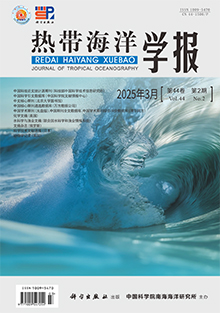Zooplankton were sampled in coral reef waters from three islands (Qilianyu, Yongxing and Dong islands) and five atolls (Langhua, Panshi, Yuzhuo, Huaguang, and North atolls) around the Xisha Islands from May to July, 2015 in order to understand the community structure of zooplanktonin the region. The aims of this study are to analyze the species diversity, abundance distribution and community structure of zooplankton, and to compare the differences in zooplankton community between the lagoon and seaward reef-slope waters among the five atolls. A total of 180 species of zooplankton including 13 groups of planktonic larvae were identified, among which the greatest species number was the copepods with 80 species, followed by the hydromedusae, pelagic mollusca, chaetognaths and pelagic tunicates. The average abundance of zooplankton was 256.4 ± 117.8 ind·m-3, among which copepods accounted for 51.08% of the total abundance, followed by planktonic larvae (16.30%), pelagic tunicates (13.22%) and chaetognaths (7.70%). Differences in zooplankton species, diversity, evenness index, and abundance between islands and atolls, as well as in the lagoon and seaward reef-slope of five atolls, were observed. The diversity and abundance of zooplankton were relatively high in Dong Island, Yuzhuo Atoll and Huaguang Atoll, but low in Qilianyu and North atolls. They were higher in the seaward reef-slope regions than in the lagoons of the five atolls. Two major assembled groups were distinguished into the atoll lagoon-island and nearshore group, and the seaward reef slope-island and offshore group at the similarity of 85%. A significant difference in the two zooplankton assemblages was observed (r=0.832, p<0.001). The former group was characterized by low values of species richness, diversity index, total abundance, and abundances of main groups such as copepods, chaetognaths and planktonic larvae compared with the latter group. The heterogeneity and ecological environment differences between the atoll lagoon and seaward reef-slope waters may be the main factors determining the zooplankton community structure around the Xisha Islands.




